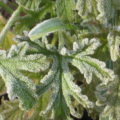Brix = % weight dissolved solids (technically, % weight sucrose, but refractometers can’t distinguish between sucrose and other dissolved solids)
One degree Brix is 1 gram of sucrose in 100 grams of solution
Abbreviation: °bx
Building Soils Naturally by Phil Nauta:
- pp 45-48:
- One of the two main instrument tests for plants (the other one is plant sap pH)
- one of the most exciting tests measures dissolved solids in plant juice (including sucrose and fructose, vitamins and minerals, protein and amino acids, among other things.
- Reasons to know & improve the brix of your fruits and vegetables:
- It’s a good indication of the quality of your soil and soil management efforts
- higher brix means balanced soil nutrient ratios, increased organic matter content, good soil food web, etc;
- it’s also an indication of taste: higher brix = better tasting (way better tasting)
- more nutritious
- higher brix = longer storage time (“very high-brix foods don’t rot”)
- seeds germinate more quickly
- plants get bigger & produce more
- resist heat
- resist frost damage
- once the brix is above a certain number (for most plants it’s around 12), plant predators will diminish or go away completely
- this goes for all parts of the plant, leaves too
- if predators are still damaging the plant with greater than 12 brix, then test the leaves – they may be lower than 12
- Brix testing can be done very shortly after spot-fertilizing to determine if it’s what the crop needs. Here’s how:
- test the brix of your test plant using a leaf or a mature fruit, if it’s at the fruiting stage
- foliar feed the plant with your test fertilizer
- wait 30-60 minutes
- test the brix again: if the brix has gone up at least a couple of points, then it liked that fertilizer and the whole crop should be sprayed; if it stayed the same or went down, then that fertilizer is not needed
- It’s a good indication of the quality of your soil and soil management efforts
- Dr. Carey Reams discovered and was the pioneer of figuring out that high brix means high quality
- Dr. Reams determined necessary brix levels for many different foods
- Brix is measured with a refractometer ($60-$100)
- some say it’s the most important tool of the serious food grower
- Phil Nauta recommends buying instruments from Pike Agri-Labs
- Gardeners can use brix to see if the food we are growing is getting healthier over time
- if comparing brix samples from leaves, make sure to take the leaf from the same place on the plant
- weather effects on brix:
- a series of cloudy days will bring down brix values
- a hot, dry, windy day may bring up the brix
- soil nutrition or fertilizer effects on brix:
- too much nitrogen will bring down the brix
- too much potassium will bring down the brix
- phosphate is especially correlated to brix (high available phosphate = high brix)
- sufficient calcium will make the line of demarcation in the refractometer fuzzy instead of sharp (author acknowledges this is his own hypothesis)
- How to use a refractometer:
- obtain a little bit of juice from a leaf or fruit (author recommends pliers or a blender – I just used a toothpick to pierce the fruit, then squeezed the juice out)
- drop some juice on to the glass plate
- look through the lens of the refractometer to take the reading
“Tools of the Trade – Using Refractometers & Penetrometers” Digiuseppe, Gary. Acres U.S.A. August 2014
- Brix = % weight soluble content, or dissolved solids
- technically, t’s the percentage by weight of sucrose, but the refractometer can’t differentiate between sucrose and other dissolved solids
- refractometers work by passing light through sap or juice extracted from a crop, and then measuring the angle of the light as refracted by a prism
- named after Adolf Brix, one of the originators of the method
- if your refractometer does not have automatic temperature compensation, you have to use a formula to adjust your brix reading, if not taken at 20°C (68°F)
- to obtain sap or juice from plant matter, as opposed to fruit, crush the plant matter using a vise grip or stainless steel garlic press with a filter, so you only get the sap
- factors that affect brix readings from a refractometer:
- temperature: this is the only one that needs to be known to get a good reading
- concentration of dissolved solids
- atomic weight of the substances
- number of covalent bonds (higher when amino acids and proteins are present)


